Perfect leather all the way around….top grade too
Let me start by saying that this is a long, yet informative post.
I made a comment on the blog the other day in reference to one shoemakeris leather being typically of a lesser quality with respects to another maker. Not necessarily that it was a low quality, only that within the grades of high quality, one was lower than the other. This comment threw off the reader as he was under the impression that leather qualities were of like-quality across the board of handgrade shoes, ranging from brands AS to C&J to EG. Let me first start by saying that this is definitely not the case. They all use different quality leathers, from different level of leather makers (tanneries) and while some might even come from the same tannery that does not necessarily mean that they are using the same leather or rather, using it in the same way, which does make a difference and I will explain it below. Plus there is a reason why some shoes cost more than others and a big part of that is the leather, especially as it is the component that makes up 95% of the shoe. (From this point onward, let us start by assuming that we are talking about factories that make shoes that retail for +$400 USD.
Now prior to making this comment, I had an idea about how the leathers differ as I touch them every day, all day long and can feel the difference. Not to mention that I own a lot of shoes from many makers. But because I did not have a factual answer to give, I had to go ask someone who would know, not only because they currently own their own factory, but have worked for others as well. That being, when a factory buys leather from the tannery, they are usually given an assortment of pieces/hides that come from grades 1-3 (1 being the highest, 3 being the lowest naturally) to then make their shoes with. I was previously under the impression that a factory could simply say, I want grade 1 leather and that is all. But clearly I was wrong. The way in which people then separate themselves is how they use all of that leather, as it greatly differs and here is the secret to why some shoemakers shoes are always brilliant and why others aren’t as prestigious.
A G&G above and a Handgrade C&J below….surely you can see the difference in quality…the G&G’s leather is much more taut and smooth, as it should be for a price tag that is $400-$500 more
Now to make things even more confusing, within a grade of leather, say grade 1, there are then around 5 sub-grades within that single grade. (grades of hide quality are separated by the amount of flaws on the hide, then within each hide you have different levels of quality from the head, neck, spine, belly etc.) That being there are many options to choose from. So let’s assume that we are now talking about factories that are predominantly going to use only grade 1 leather. Now when you get a hide of leather there are certain parts of it that are better than others as there certain parts of the shoe that are more visible/prominent and thus considered more important than the others. For example, the toe box of a shoe is the part that everyone notices and sees and therefore needs to be of the utmost quality, usually the leather that is the tightest. And what part is the tightest? The spine area is, which would be the center of the hide. And the more that you go away from the center and thus reach the belly of the cow, the looser, wrinkly and veiny the leather gets.
An annoying discovery where my factory thought it would be intelligent to use a good piece of leather (the spine of what looks like lower end grade 1) and a bad piece (the belly of what looks like grade ⅔ leather) to make one pair of shoes…..I clearly had to send that back as a reject!!
Now assuming that a factory has this slab of leather in front of them and assuming that utilizing one slab to its maximum potential can cut you 6-8 pairs of shoes. Now the difference is that one factory, may use the center to cut out all of the toe pieces/plain toe vamps etc. and then use the side of the slab to cut all of the heels/quarters/facings and maximize that slab to the fullest in order to get 6-8 pairs out of it, but still using all “grade 1” leather (but remember even in grade 1 leather are subgrades that are not as good in some parts of the hide as others). But then there is the factory that only uses the center of that slab and gets only 1 pairs worth. Which shoe is better? So, you see that even though the leather is the same, the factories used it differently and one factory produced a shoe from only the best part of the cow while the other used parts that aren’t as good but put them in places not as noticeable and thus not as important. (and if you haven’t figured it out, the brand that cut one shoe from the leather as opposed to 6-8, is going to be at least triple the price).
A G&G and a EG….nearly identical but seems to be a slight difference in the leather used in the facing (could be wrong though)
That being, you see now how they all vary and how EG’s leather will be different from C&J handgrade, which will be different to G&G and Lobb and Corthay etc. Plus then you have to factor in that a lot of them then get their leather from different tanneries that produce different types of leather. For example, many English factories tend to source leather from Italian/German/Polish/some French tanneries that produce a thicker, heavier and thus stiffer leather whereas many French makers will get them from French tanneries that produce a typically lighter weight, thinner and thus more flexible leather. You can also buy different thicknesses of leather. Thin ones will wrinkle more, whereas thicker ones do not as much. Whether one is better than the other is subjective really. I believe that the ones that British makers get tends to hold its shape a bit better where some very high grade French calf skin are so soft that they crease very easily. It does not take quality away from the leather but many people associate the idea of bad leather when it creates a lot of wrinkles. So as you can see, the leather quality to a shoe is a tricky concept grasp as there are so many components that make it up and thus comparing leather qualities is even trickier, but allow me to say that they are all different and some are definitely better than others…
The moral of the story is that while many brands will use different tanneries for their shoes, the important thing to realize is that one of the major separators of price is how many shoes are cut from one hide. The top brand in the world whose shoes cost $1500 USD retail could source the same exact grade one leather as a brand that charges $500 USD but the more expensive brand might cut only 1-2 shoes while the less expensive brand utilizes the entire hide or around at least 80% of it. But at the end of the day, it is the same leather i.e. tannery and grade of quality.
Belly used on the inside quarter/counter not great, but not uncommon for a shoe $300-$400 welted shoe. Some might scoff at that, but it is the reality.
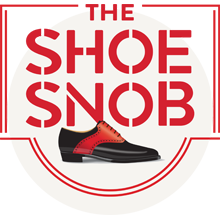
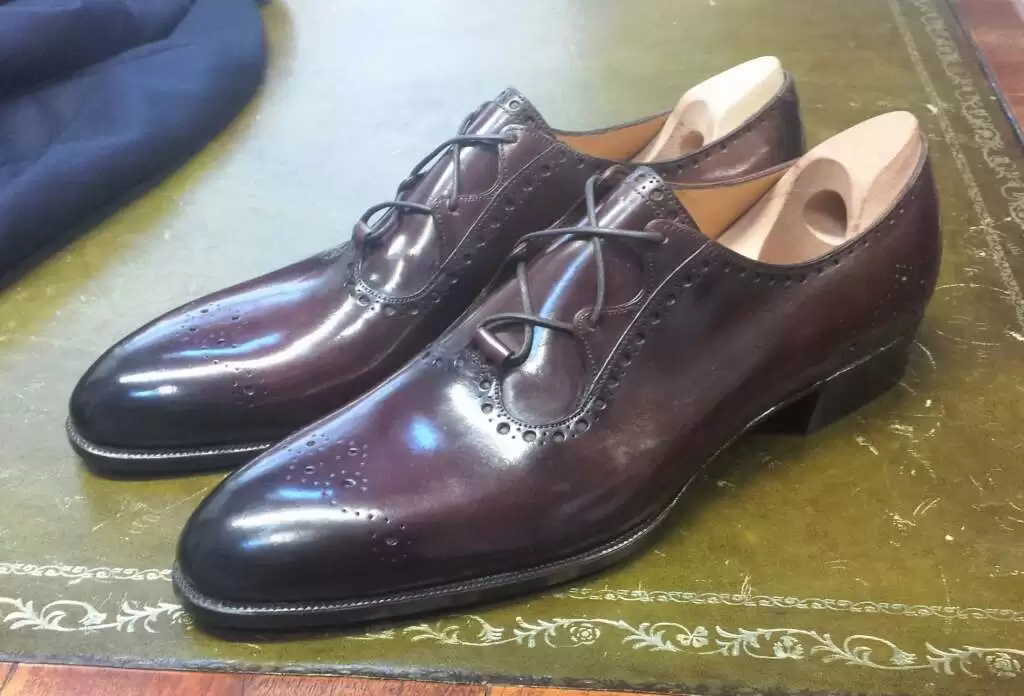
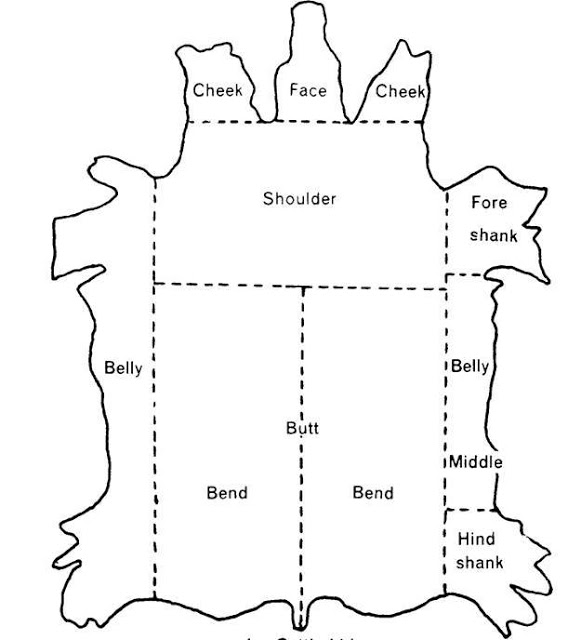
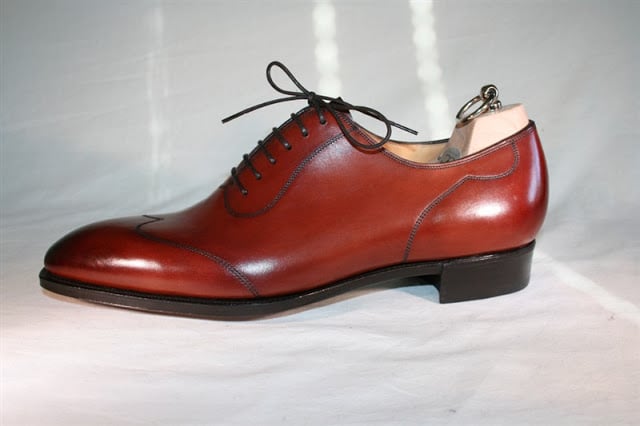
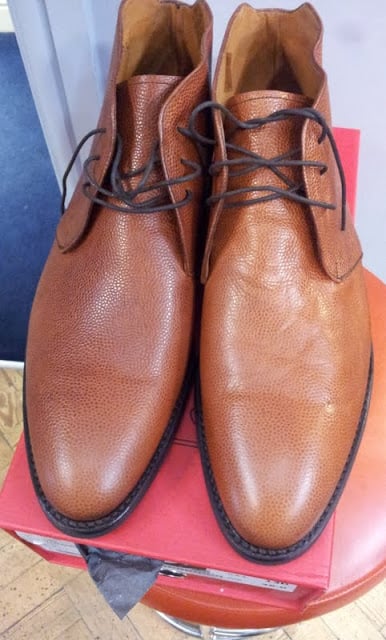
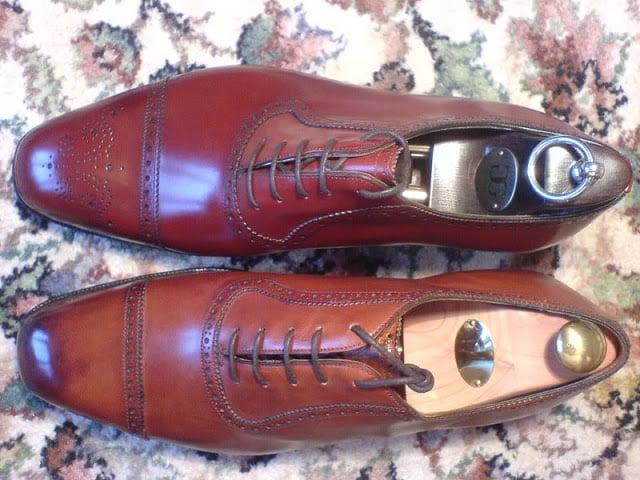
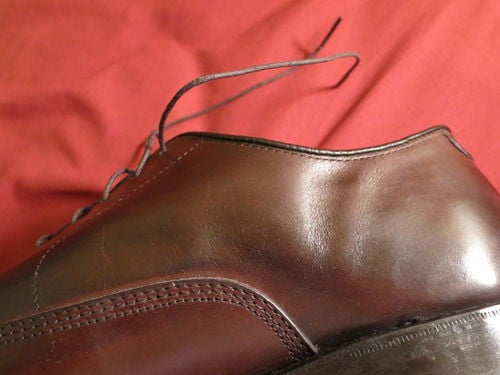


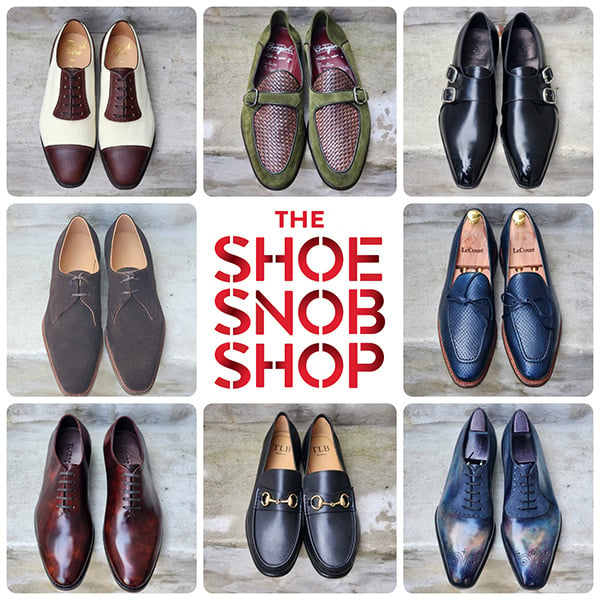

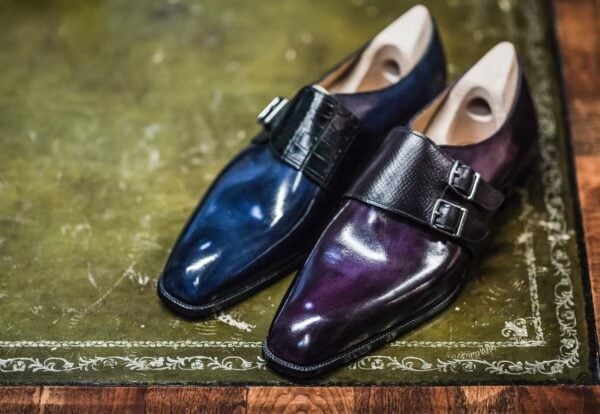
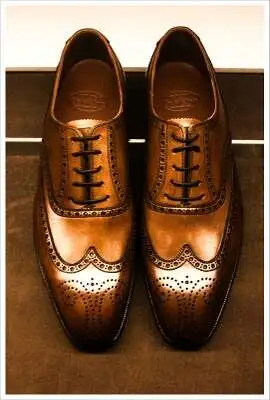
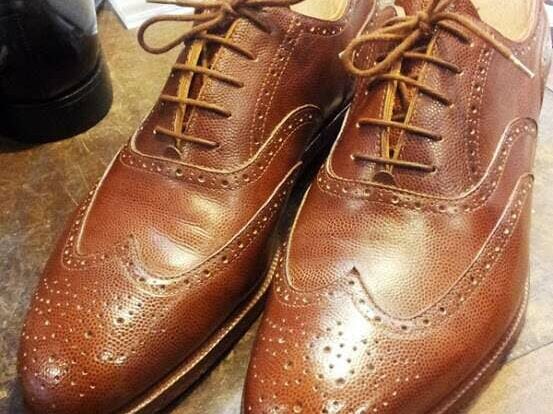
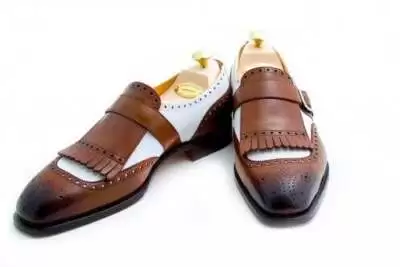
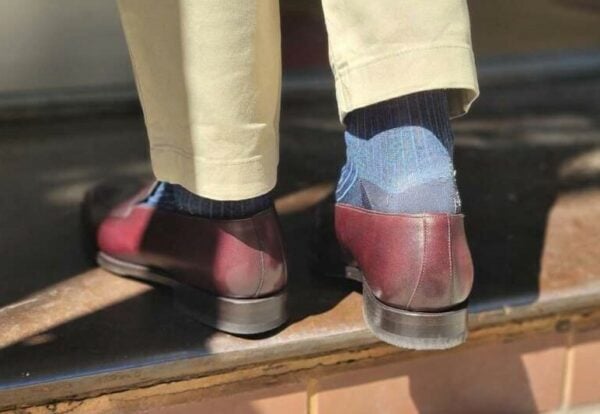
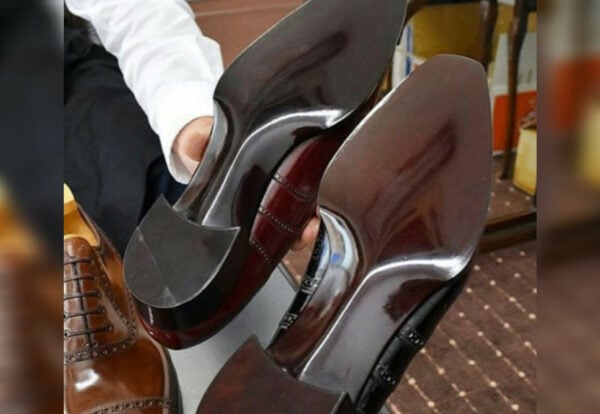
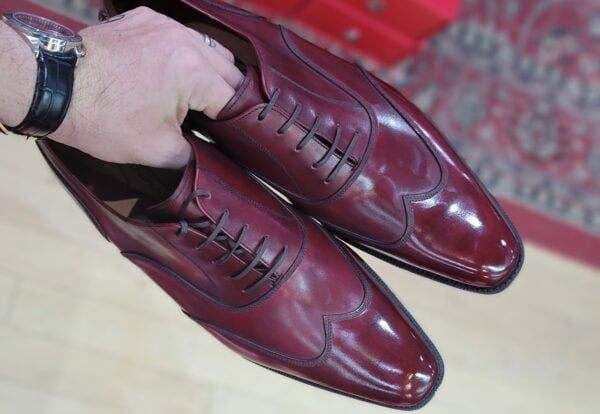
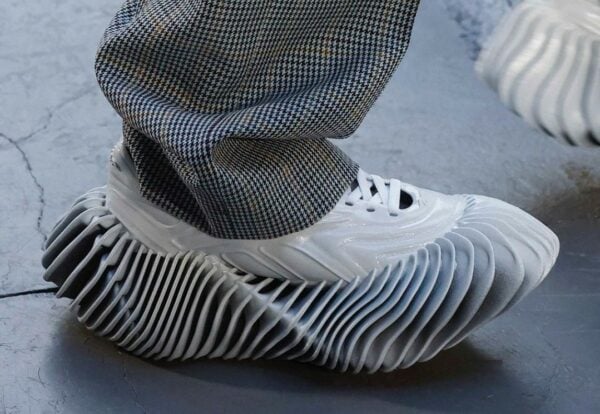
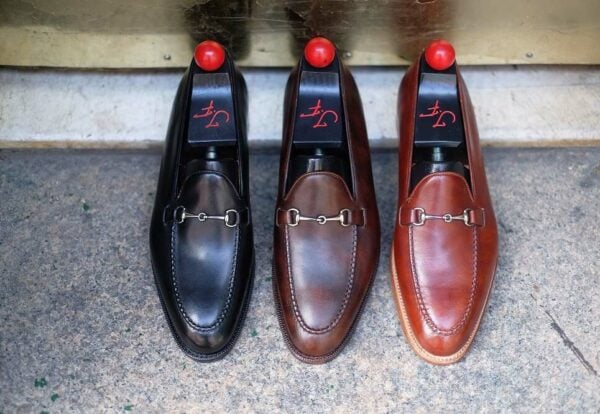
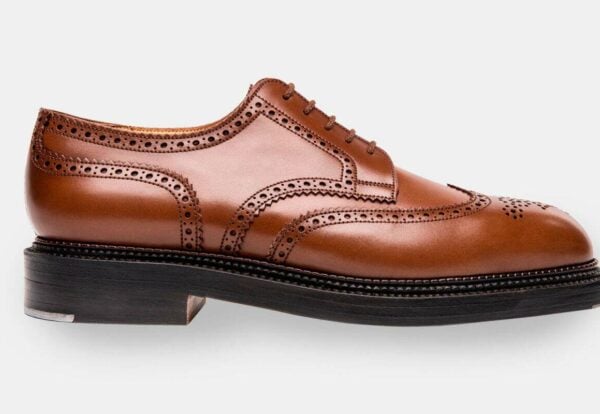
Keep up the great posts, always nice to learn something new about the industry. The shoe pr0n’s great too.
Regards D.
Thanks D! Appreciate that.
I could be wrong, but the G&G in the first pic looks bespoke given the box where the logo is printed (i.e. definitely +GBP2000)
you are correct….that is why the leather is absolutely flawless….
Great post!
thank you!
What do you think about the Saint Crispins leather? (and comparing with G&G leather). You have very instructive posts.
it is good from what i have seen & experience…a lot different than G&G but equal in quality…Saint Crispins use a much stiffer and heavier leather where as G&G’s is much softer and lighter…I prefer the soft and light to be honest….but one is not necessarily better than the other..it’s a matter of preference at this point…
Great text Justin! These things have been written about before in various ways in various places, but I’ve never read something this pedagocical and clarifying. Interesting also that french tanneries produce thinner leather that you believe crease a bit more. I’ve never thought of that, and for an amateur like me it’s always hard to tell how thin the upper leather of shoes are, expecially since manufacturers use different thickness in the lining leather, some use textile inner lining and so on.
http://www.shoegazing.se
glad that you enjoyed it! At least from what I have experienced, French calfskins always seem to be lighter and thinner with respects to their German/Polish and even Italian counterparts…And while i prefer them, I have noticed (especially with my bespoke shoes that I made while with Bemer) that they crease a whole lot more….
Have you found any strategies to decrease the creasing besides the usual shoe trees/ polishing?
-mel
Hi Justin,
Thank you so much for this clarification! We are really gratful to you! For sure, I’m not the only one to appreciate this piece of information you have provided.
It is indeed important for shoe lovers to know for instance that the quality of a very good pair of shoes start playing out at the level of the choice of leather within the top grade ones. And therefore there are top grade and top grade!
I remember a piece by Simon Crompton (Permanent Style) in which he was advising – with British shoemakers in mind – to consider shoes whose price tags start “at � 300 and something”. I then took it for granted and didn’t bother asking him how he reached this. Interestingly enough, it is the same indication you are also giving here! So below this freshold, one is, if anything, likely to witness creases on his shoes which are rather not nice, besides the longetivity issue! This is to me the first thing worth considering indeed well before going any further as to the quality of the lining, the insole, etc. etc.!
Now, the question that springs to my mind is this: has the way a shoe is taken care of any impact on how it creases? Knowing of course that its durability highly depends on how it is polished.
Thanks again for your commitment to our better appreciation of this fundamental piece of our wardrobe!
John
PS: For Fall and Winter shoes, I think the thicker leather is better even if they happen to be oxfords!
john, glad that you enjoyed the post! As per your question, well nothing can prevent creasing, but one can use shoe trees that are slightly bigger to really fill out the shoe and thus push out the creases as well as keep them from setting further into the leather…of course, regular nourishment of the leather (with stuff like the mink oil renovator) will help to make it soft and supple which also helps in making sure the creasing does not stay prominent…. hope that this helps and thanks for your appreciation of my work, that means a lot!
Hi Justin,
Thanks for this advice.
You are really doing a good job, not just for us your readers, but also for the shoe industry itself. Look, less ignorance is better for them too. Frankly, how could one otherwise understand why a pair of G&G or EG is so expensive?
Presumably, in the long run there will be a pre-and-post-ShoeSnob readership signaling a broad devide between those who can confidently set their sight on a pair of shoes, and knowingly buy it as a wise investment.
Thanks for the kind words my friend, glad to know that you are enjoying the read!
Thanks for the very informative post, & esp. for the photo clarifications of the points you’re making.
Nick D.
my pleasure Nick!
very interesting! I think this helps explain the otherwise faultless ‘seconds’ people pick up from the northampton factories and the london shops during the sales, Ive just gone to a pair of cleverley that i picked up in the christmas sale and the leather in less noticeable areas isnt a good looking when viewed next to a pair brought at full price
you are dead on with that statement….
That was an exceedingly informative post – I learned a lot.
Glad to hear it Roger!
For your shoe line, what portion of the hide do you use?
For someone who doesn’t handle shoes everyday, how can we really have an idea of the quality of the $450+ shoe we are considering?
In other words, can we as customers really tell the difference between a Alfred Sargent shoe and an Edward Green shoe? If so, how can we judge whether the additional cost is truly worth it?
that’s a good question to be honest. I don’t control every step of my production, only the final product, so I can’t say with certainty. From what I have seen, i would say anywhere from lower end grade 1 down to grade variants of grade 2….if they use a grade three and it looks bad, I simply reject the model and send it back…. As far as what portion of the hide, I am sure that my factory uses all of it…we are not G&G or JL and my prices show that…
For a person that doesn’t handle shoes everyday, well you just have to use your eyes and the best common sense possible…but from what I have started learning about shoes, consumers cannot expert the highest levels of leather on all shoes above $450. One cannot expect C&J to have the same as G&G, nor even more ridiculous, is the belief that Meermin at those prices should have the same consistency as JL or the likes. The price of leather is continuously rising, especially as these big stupid conglomerates keep buying up tanneries….I actually fear what it will be like in 5-10 years…. But as a consumer, well price should tell you that there is a difference in leather as it is the main component of cost…
Great post, Justin!
thank you!
This is a great post indeed! Now, we know you are enthusiastic about – among many middle range shoes – those of the French Septi�me Largeur. But what about the quality of the leather this shoemaker use?
This post and the ensuing comments have completely changed my personal approach to shoes. From now on, before buying a new pair of shoes, I will adamantly stick to 1. the quality of the upper leathers, 2. the construction (Blake vs Goodyear, and quality), and finaly the style. In that order.
But then, not being in the know, I wonder whom I should then rely on. Unfortunately, more often than not the sellers do not know either…
It’s hard to say my friend…they probably use a mixture between grade one and two and possibly even three…I don’t work in the factory, so I can’t really say for sure what they are using…the eye should tell you though….but at their prices one cannot expect to only get grade 1 leather, that is not practical…. Glad that you enjoyed the post!
If I may briefly venture a bit downmarket from the likes of G&G, can I ask. Question about Allen Edmonds here?
I was told the other day that Allen Edmonds use a higher quality leather for their own shoes than for the visually identical shoes they make for Brooks Brothers.
Is this likely?
Laurence
like I told the guy above, I can’t say really. It takes one working in a factory or tanner to know these answers. A lot of what i got in this post, was from an owner of a factory that only uses grade 1 on their shoes. I suspect that Allen Edmonds is using anywhere from lower end grade 1 down to grade three, but this is just common sense speculation, no proof in it… I am not sure if that other statement is true as Brooks brothers would notice it and reject the stock, which would create a lot of waste for Allen Edmonds…
great read thanks Justin
My pleasure!
Great post Justin! Now I just need the same simple clarification for alligator and crocodile skins used to make shoes.
Thanks,
Leo
for croc/alligator, a good maker should only get one pair out of a skin….
I am planning to make my own leather dress shoes but I would like to know where could I obtain the best quality leather. What should I use? I never made my own leather dress shoes before. If you can kindly tell me I would greatly appreciate it!
you should use calfskin and you can get some at http://www.aacrack.co.uk/catalogue.asp?page=home
its hard my friend, unless you really know leather…plus just because you pick something doesn’t mean that he will only use the best pieces of the leather too…he could very well use the belly..best to ask where his leather is from, what tanneries etc…good leather comes from France, some Italian, some German/Polish, Suedes from England etc…best of luck
you should read a book called Handmade Shoes by Laszlo Vass…you will not gain the skills from this website…no untreated leather is really water resistant…
Hi, I would like to know how much leather is need it to manufacture a shoes? (Approximately) Thanks
depends on how much of the leather you are using (quality wise)…for 1 square meter, you can get about maximum of 5 pairs.
I have just discovered this blog a few weeks ago so forgive the comment on an old post.
A very insightful and enlightening post. One point troubles me though (and would be grateful if you could clarify), I have been told numerous times (including by those in the industry, I think at one point it was even mentioned in a video by a Crocketts employee) that C & J, Trickets etc use the same grade leather as Lobb & Edward Green and that the main difference is that the latter use the hide far more selectively (Lobb gets a single pair out of each hide, C&J gets 2-3). This obviously leads to a difference in quality, and I may have misread your article, but you seem to suggest that there is a much larger difference. From how it was explained to me, I was also under the impression that construction, shape and labour played a much greater role in price (at least at a C&J vs Lobb or EG pricepoint) than the quality of the leather. I tend to believe this as looking at leathers which can only be bought at one quality (like Shell Cordovan, which is graded by size and not quality) the price gap remains unchanged.
For the most part you are correct. But when you buy leather from a tannery, you have to buy an assortment of grades 1-3. They will not sell you just grade 1. They will sell you just grade 3 if you want but if they only sold grade 1 to people some massive brands would buy it all up and create monopolies so there are rules put into place. Yes, it is rumored that Lobb will cut one shoe from a piece of leather but I am sure that they will do so from grades 1-3. The grades simply denote the amount of imperfections on a hide that is about 1.5-2 meters squared….you can cut one perfect shoe on a grade 3 hide. But not more than one. So yes, you are correct as we are mainly all using the same quality of leather (those from +£300). What separates the pricing is the amount of wastage one is creating. But there are tricks to shoemaking too that can make leather look nicer. The better a shoe is lasted, the better the leather will look. Loose leather looks bad, tight leather looks good. And there are many other factors too…finishing is a great part of expensive shoes.
This entire blog post and thread of comments has been so insightful, but this comment is so on point. Eye-opening, to say the least. It’s all starting to make a lot more sense, in terms of price points and what cause them. Appreciate you and everyone participating here! Four years later, the info is just as relevant!
What kind of leather is the one used on shoes Image #4 ?? It’s not as shiny as the others, it is not intended to do so . How do you take care of it?
that is regular french calfskin. It is not shiny as they did not put any polish on it in the finishing stage. You would care for it just like any other leather
C&J is better IMHO, go that route
Isn’t the “C&J” actually a Ludwig Reiter?
no pretty sure it’s the waymouth — http://www.crockettandjones.com/product/weymouth-darkbrown
Hi Justin. These days leather seems to range from calf to camel. Apart from their texture (aesthetic) is there a stark difference as to where e.g. quality, break in period, how it ages is concerned? Is this also same where different suedes are concerned? I ask as i am confused while trying to pick between leather for my shoes. Thanks!
yes, it all varies and unfortunately I am not really able to explain it all here. Maybe I can make a post of it soon
HI there. I bought me a pair of ankle leather boots. The two somehow differs slighty in colour and shine. Is that normal ??
that very much depends on where you bought them, the price you paid and the quality of the manufacturer. I need more facts before i can answer in a concrete manner
I have a pair of ancient Florsheim plain Cordovan and wingtip Cordovans.
I have used black sole edging on them – is this wrong. I forget what color the original soles were.
Also, I have been insisting on leather heels. when they are replaced I get a leather heel with a triangle inset of metal to deter wear.
The metal triangles make a click on stone and cement – does this make me look bad?
I put metal toe caps on the front end of the sole on all my shoes but never heard of metal heels. I can imagine they can be quite damaging to wooden flooring.
Very interesting post on understanding degrees of leather quality.
What confuses me most about comparing leather quality across brands is the proprietary element from some luxury brands. Examples that come to mind: Berluti’s Venezia, LV’s Epi and anything from Hermes. Clever marketing for sure but it’s hard to evaluate the quality since they have such distinct qualities.
https://uploads.disquscdn.com/images/4f1b9a5eb44b8510c5f5ff9cd29d697867db776e3f66fa6aafd7a77f68ef4055.jpg I recently bought a pair of men’s shoes (used) and I cannot find any info on the brand. is there anyway that you can help?
I always (mistakenly) believed that higher quality leather would crease less or not at all as compared to low quality leather, but this post has helpfully dispelled those incorrect notions. In that case, apart from your brief comment that higher quality leather feels softer, nicer. smoother and is more taut, what other features distinguish great quality leather from poor quality leather (assuming that full grain leather is used)?
I ask this because from my reading on SF, there appears to be a general consensus that some brands (e.g. G&G) use much higher quality leather than others (e.g. Loake). Practically speaking, what are the differences between the qualities of leathers used between these brands, and would it be possible for a trained eye to discern quality of leather from a glance?
Thank you so much for your post!
“Leather makers” lol. Is that next to the factory that makes eggs?
Next to the factory that makes the chickens, actually